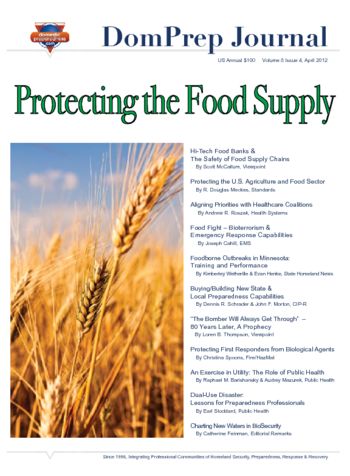

Charting New Waters in Biosecurity
Catherine L. Feinman
April 25, 2012
Many businessmen, and homeowners, would quickly buy and read a comprehensive report on how to
prevent burglaries. Many burglars would buy and read the same book, but for different reasons. Those who
carry out important scientific research face a similar dilemma: They want to help educate their peers,
but do not want their findings to become available to those – terrorists, for example – who would use
the information in ways that would harm others.

Protecting the U.S. Agriculture and Food Sector
Douglas Meckes
April 18, 2012
The well-known military axiom that an army “travels on its stomach” applies equally to a nation – more so now than ever before, primarily because of the massive increase in the international trade of food and agricultural products that has taken place in recent years. For this reason, the accidental and/or intentional poisoning of food is now a major U.S. national priority that will undoubtedly grow in importance for many years to come.

‘The Bomber Will Always Get Through’ – 80 Years Later, A Prophecy
Loren B. Thompson
April 18, 2012
Not quite 80 years ago, Britain’s de facto prime minister made some shocking comments about
military policy before Parliament, and his countrymen. Since then, many “inexpensive” attacks have
required “expensive” military defense. Today, the dangers facing the entire world are even greater and
the cost, to all nations, of not facing the facts could be truly cataclysmic for many decades to come.

Enterprising Solutions: Buying/Building New State & Local Preparedness Capabilities
Dennis R. Schrader and John F. Morton
April 17, 2012
For more than a century, the United States has followed a “forward defense” strategy – in other words, fighting the nation’s battles overseas rather than in the United States itself. The 9/11 terrorist attacks led to the realization that homeland security must now begin at home. The federal government has acted accordingly, but individual states and cities still have a long way to go. Here are a few helpful suggestions to follow.

An Exercise in Utility: The Role of Public Health
Raphael M. Barishansky and Audrey Mazurek
April 11, 2012
The federal funding streams that improved U.S. preparedness capabilities, at all levels of government, so significantly in the first decade after the 9/11 attacks have already declined, and additional reductions are just over the horizon. But a lack of funds can be overcome, at least in part, by careful planning, increased cooperation, improved training, and a more imaginative and continuing all-hands effort by all of the professional preparedness communities directly involved.

Foodborne Outbreaks in Minnesota: Training and Performance
Kimberley Wetherille and Evan Henke
April 11, 2012
There are almost 50 million foodborne illnesses “of various types” in the United States, and over 3,000 deaths annually. Those are the grim statistics that persuaded the U.S. Centers for Disease Control & Prevention, the FDA, and NACCHO to expand and upgrade programs already in place to detect, control, and prevent the spread of foodborne diseases in cities and states throughout the country.

Food Fight – Bioterrorism & Emergency Response Capabilities
Joseph Cahill
April 11, 2012
Infected salad bars and the “improved” technological capabilities of modern-day terrorist groups have combined to make U.S. responders, and the American people, much more cautious about what they eat. Fortunately, that heightened awareness has led to a much closer scrutiny of restaurants, super markets, food-processing plants, and the super-rich diet creations to come.

Laboratories and First Responders: Collaborating for Effective Response
Maureen Sullivan
April 10, 2012
Each day, events occur that engage personnel from multiple disciplines who are each tasked with the
common goal of protecting the nation from all hazards threats. Even though laboratorians, police
officers, firefighters, and hazmat technicians wear different uniforms, they all share the common goal
of protecting the public and thus have similar concerns. Listen to APHL’s discussion on the
collaborating efforts between first responders and laboratorians.

First Responder HazMat/CBRN Training SURVEY
Domestic Preparedness
April 5, 2012
Your Opinion Matters! DomPrep wants to know your opinion on preparedness and training efforts
related to chemical, biological, radiological, or nuclear (CBRN) warfare and hazardous material
incidents. In today’s environment of reduced funding, maintaining these efforts can be even more
challenging than in the past. How prepared is your jurisdiction? Take the survey now!

Dual-Use Disasters: Lessons for Preparedness Professionals
Earl Stoddard
April 4, 2012
Actions have consequences – not all of which are intended, or desired. Some military actions, for example, are intended to intimidate another nation – but instead lead to an outright war. The same is true in the fields of medicine and biological research that, while expanding the range of knowledge about a lethal and previously unknown disease, might also open the door to a new pandemic.

